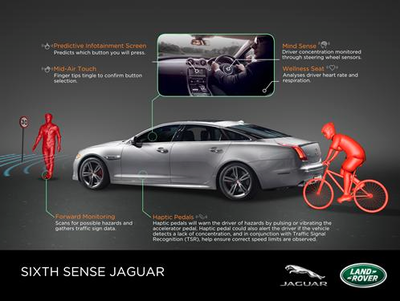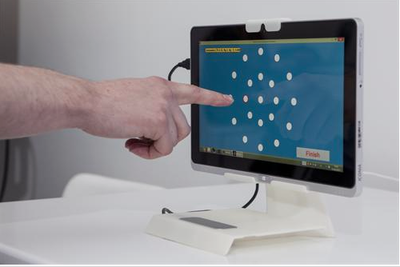British automaker Jaguar Land Rover is researching the brain and driving behavior to create technology that may improve road safety.
The automaker is researching the neurological causes behind on-the-road distractions in an attempt to protect drivers from bad decisions and tendencies. As autonomous cars become more plausible, automakers are discovering that a hybrid between machine-driving and human-driving will likely be the preferred solution.
"We believe some of the technologies currently being used in aerospace and medicine could help improve road safety and enhance the driving experience," said Dr. Wolfgang Epple, director of research and technology at Jaguar Land Rover, London. "The car is becoming more intelligent and more able to utilize cutting-edge sensors.
"These research projects are investigating how we could exploit this for the benefit of our customers and other road users," he said.
“One key piece of new research is to see how we could measure brainwaves to monitor if the driver is alert and concentrating on driving. Even if the eyes are on the road, a lack of concentration or a daydream will mean the driver isn’t paying attention to the driving task. They may miss a warning icon or sound, or be less aware of other road users, so we are looking at how we could identify this and prevent it causing an accident."
Fixing the disconnect
Consumers often forget that driving a car is dangerous, since the experience is so cocoon-like. Drivers sit in their comfortable seats, listening to curated music as air-conditioning pours from vents, while they maneuver a one-ton hunk of metal down a road swarming with other one-ton hunks of metal.
This disconnect clearly plays a part in the prevalence of car accidents.
Jaguar Land Rover wants to mitigate this disconnect to some degree by lessening the chance for distraction and is funding various "Sixth Sense" projects to do so.
The projects draw upon research from sports, medicine and aerospace to "monitor the driver’s heart rate, respiration and levels of brain activity to identify driver stress, fatigue and lack of concentration."

Sixth Sense Jaguar
The team wants to minimize how long drivers spend in a state of deficient attentiveness.
Ultimately, the devised technology will be able to read and react to a driver's brainwaves to change the in-car experience on a moment-to-moment basis. If a driver is becoming sleepy or is daydreaming, then the technology will coax her back to attention.
For instance, a "wellness seat" is being developed to analyze heart rate and breathing to determine health and stress levels.
Also, touchscreens that can predict which button a driver is about to press, allowing for mid-air execution. Sensory feedback will inform the driver that the button has been activated.

Research for Sixth Sense Jaguar
A haptic accelerator pad will also be introduced that can warn drivers of impending hazards. For instance, if a deer appears on the road, a vibration on the pedal will alert the driver.
The "actuator" can also send signals to let a driver know she is exceeding the speed limit.
Brainwaves will be monitored by the steering wheel, which will be able to "filter out noise." According to the brand's research team, the brain generally produces brainwaves with distinct frequencies that reveal if a person is focused, daydreaming, sleepy or distracted.
Drive safe
Jaguar has pioneered other technologies that aim to lessen the danger of driving.
For instance, the brand is working to eliminate drivers’ blind spots through the introduction of its 360 Virtual Urban Windscreen technology.
The automaker’s latest technology concept is still in the research phase, but is set to change how drivers operate their vehicles and reduce collisions. Automakers commonly tout the driving experience through experiential initiatives, but recently there has been a rise in technological advancements such as automation and digital windshield displays meant to elevate daily interactions with an automobile (see story).
Also, Jaguar Land Rover is looking to make urban roads safer with features that will alert drivers of the presence of bikes and motorcycles.
Every year in the United Kingdom, 19,000 cyclists are killed or injured on the roads, but with Jaguar Land Rover’s “Bike Sense” feature, cyclists’ presence will be more obvious and bike-related accidents will decrease. The addition of this feature will likely draw attention from consumers all over the world, especially in cities where bikes and scooters are a common means of transportation, such as Beijing (see story).
"As we develop more autonomous driving technologies, there will be instances when the autonomous car needs to hand control back to the driver," Dr. Epple said. "To do this safely the car will need to know if the driver is alert and well enough to take over."
Final Take
Joe McCarthy, staff reporter on Luxury Daily, New York
{"ct":"qpzNx8jcRujI28BQcs7cxXgqkLlZHxD+\/en6dHQrKGj3Wxle2tOWFJcXnKL4yib0TUhQnKNspuKB\/hzY3i97l6RDTh8FnQJuNZsvHSL6VhQSyYDPdjlE+17YeYzGQQZY\/ZNPXr1oOjKO\/QEr1QBsARRF6CiCUdWGwdzO+f\/bSMfS8cbtNVZtAXLIs3uWpK0DTtA35\/H+3z6TaRNp9f4C60UeqVjSLjHBGGTTXjpG5k0CrIntzTEdutooA7\/zd15I9+CFpT\/Uwhg0dkNjzq3UFaH7brToW0zYIG6BXWBmKtMbfAv3IaAeZpfLD9I7BJ+PkUOTOkftrlCqspVEKfLTAflU3luvqbkWSKishz7w18QjZWmev1rDhwbH0uAtr4eA5HrIlzm\/tnR8tvK2MvAnQVklTJhnXuHZF2Uy78ESPL7UbJCjv8RiD+HmDQUigIXDySWxCNduR5VJUQwnZR0Cin8Hql5ILGm\/QN7JV4MXcC7L8\/iRSXkG39bUv5lMBJKa1QbLKpAKaBvL3S20R5QLAv\/f6w5HcKqiM4dKSUlG5s3YYE2C9M\/\/Ja612q\/O1GeKuSx+UvEnyUa2MYZIP5uKKJk8NHSaMGxUvjUdvdWiJH1vIU2Ep3gTHlizor6DhreFZ8fRBTxX\/FW70RD0WUeM27Bllw\/QeYedtlwvWz6omd\/vuccWeFBHOUDclYrGToSnf0JTg39eUabjOM\/axQoVsiwbQlhUjf3L1AnVwkvq54+M4YdWJRhAgOTpCuVOp5e+fjCGbiNnIWdlUn\/DMAl814tTqj7XjzE+2Zvm5OgC\/\/lOC7BmOFve35GzdEUX3PuP1Sqz5cS84F4LYh3NuZHTHoNTLTZ6K4Cpu1RN3ngSNpyHH+Ynu4PllgkITSLmc2zVr1B1QD0p3DRlriG6i\/mGSyGKPWW6P90jpm1gwDy3wbIN\/RgAMTKO0\/q3sRJ85PRSJ8IZmU1J2bAfhOSDIjknxQ4XRwYvKdKOrNGZbTP5ztAQ9CRQ+anXZjHN4QTLcbB6zCjipZ2GU0Z1rVCMO16pmFivu1p53R7\/IPd+i3MKlCCIZOGLktD8gi+ss9Dl0NTzLIu+b68ZE8QKi2lQfjIjRVRXrn0x7LrdywZVefQdw\/Mt9RUQZ4wtBfSYpzzzhtcXEhj57DHHGxRFlqGIFGoBmb2H\/8RVA4Us1PX5solIzxlqM80ZNEYCXJEUdU4yPEeiaiew0PhOY0MHWWhUvrk2eX+7tOpqfgKx\/FGWlOf30DFbqZTs7N8SEOH+crDq2a1PNKr5TtUKzFTT71TvO8DgBSXajoveHhZ7JPlTLGCc9aw+16VBFz254YHwQnO1idM1FCtTvlYszmwzetuzEzcVmaSs71kFloRL5O6Qt8dgG1SXRJ9wPa3wc4J7jlSVr4pRaPh8rZWeaaOF2g6PFmUbzeo4GQK6l6ipBZ\/hPeJqZZH\/WBr4S3edIEtmAjZv16GF\/40zx5fbXqDXd2iXM7QzuaoX7GN+zjCQj7luP7jg56CT8R19I+VVaiFsgOSPIR7BLDxLte+iB7dWwcVakpbgMG7THOX9qHmz660vr+oZwewCcZd5PonUGZd4e0bg\/BV9pOCkuWLOkIemE8gWkdf6xGIPaGcfCbpBlqA7X4YAJWj7Fpi5G0A+vEGgReRnKz23zyaQywEZKLP7rv1HlpzWWXOuw8cfbHhvpqW085UUrEYW\/Kk7QpC0w2yEHpMQDxTBp9lb5OyRJz\/D2wMHKoOfOZqQfu6VrRkS9Yf71iycGvkFOLyCfPZQk425nA+scQvQxV+VDMy2t9uhuRE3skK6SLdip7cvhYrmGymK247RwBQ1FKifAj3uTOtAwhLba7K6rOt3xaIc9uaiM94vvrb6FjDfZbpFOS7w5s9cdxP4j27paSfcyQ0vRD5HY6bSzseaG9mjDnA2yNGdVCvgVs0KuHulLeBW+KxXPWwZx9tV8ubqBcXfRPfQyxdswzbKy\/eV3owV\/euBGTQ\/b9pg1I4RZjJ9r7qEvetS4yKLhLreJ85UdFVTUN\/l3bjCGjlhLDgwy7sEYE3yZxywj3IBH42Z4E5sT+0Lx4PertoreKkL5BwAITG2MukDMpMDqKYkoeHzJUPZ+12g84X04fVQM98QOKSA90rB563nCl3URNgDAyPHLW2F\/oe9E0TwZ1mRP9KBYFAHjQWY9s0F62wr0rud4a4hHN59ZWyv6UVJhTGrCEIfuKZEI2uRyQzz9zUYLqk5nLVrfj4fcDQJHzMWdYFE2\/qCpYnxplNTUepbZnzeJrj1yiJpMOw2aGkXwx12bGG4T4nDVX+E7Lz9XC1l+w7KX3re6+ttRgwOKk6M57xVP31742MdcgBKlX0wcV1KSdLmsDp9zpjB9UKLONBnKGzlEyWFPJuVovnyTRwRj3zbijTSZYpa8bm\/XHNlqAJAOB33CZRnWd4aiS6+rI6eQSPgPwgUZAfIQYLVM9Ihwov6CY3W+jJHXwMKaNrJFRo8IYk0T8H4N2r9Q\/4NFOGze4ONTiAEq\/T784Rt7FI9fXHVK205kkKJvUaVa9f4HAbtyLsbPpXYEdt1VzL2riE26miP6vsH+hf9v3sp6\/GgdvEQnK+ebfVgqA1I+8IkjBoDKdtrK5f5lfVQdDMKMOP9F2MAiAy1D5UbGJhDQ9HAIZr+lQE7otS\/IGCFqj7VsbBvp6b3T76wbpUI7I\/9BMbnGKoWSzU0uARfhOGdWqdThxQNnRpOaaiw9YLtuesCLHNlLcZP1Jv3\/L1QJD3IrqmX\/xX8G8pkY15beEpl08de\/WodzXzR8p2X1+XZB9I2p6iDtWCF\/0rD4N5ljPLZ3jN161fCZFKGOJAoMas7095iDlvZXmEaqEBUkwZWWBjVizL\/j3BjdwedbVeHdEs47D5hDvyPscKzSMYbhNmKTmjriQO52mFwHnnwFv9kbZg8UJHfolS27osNtdfItzcLXvtzzKRUmtP0Lh3JsZzAX\/D2zL+QVX+kII1KzqgNDmfBnaO7UX8iNkjD+CzfDJhMunDtxjp8TcWTMo5AgePlVdKOFmrLTC+oG8cvOkQ1ed8hTkLLeiFguEFI1xi6A4Nr0W1namLPseQdBT0XBKsiZwRNQ\/+p+BTwm2Uz+ttmLUQt5cy\/UIzFfxppUIVyDCeEjS6iJwM7hUdIYWVfOGiQCBqxMjXZHlG5Ub824a+yA6JZTbBKrUILS3hBf8llxzB\/dyIGk8zBuGnEcPFNHZ3nQuZFUL5qKDaC5mtfRZLsG4ZLAfTbulr3EdbUlpvsXlz2Yhdips27ZUAEccpbC0Ynrx4IZ6hxLdTUsoCTRLWPUdZ\/j1HOwUlgS38Ndxjz1rF\/1JhWPOevp1TiMGeIOUqvVKa1iFrQ3TZ7NuTCek3SGKuBAj0K+EDEC1v+I+DSxJYlIonPJ4+i7kRXc\/P9k\/2bCNNB1YiUp7g9Hbg6us7+h6M5hYAD7BODiJ+5NxAaH4FfvKMpUByc7E8M4sgww\/m\/aeXZilct7sHEuKZw3XmN4BpxObMaR0usK1cPt3661D3nJmgVmI\/LltMgyL7n6bzl4\/RrD\/EDLVl1eenFPkEbOWcOaB3+EXFNthNilCDp2FuXHGcAYjRBhMI3XnX4h89g1GvGWZ7AdqM\/WPiq0F9JLHr8YT1AY\/mCkRHqiN3Rwbs0y\/h\/UEMi6CKJA6MxqaZ6Sh1dkrD489RYBtj\/i\/Q6EG2haoS4RMcYt9rDc10iqJT3\/Ak+MG3sxzdnYpS0ixekL+hUV7WgrYhUJAFlyHmZ0hEA88aaN7NOPEP\/igaRJa8Q\/BrGKeh8KPRG26Y7iOX6Who8LuscrZE00IJh136I7YlqoSw1qI67G50beLbpTBfbrGtAqMtCHIf6nDb\/3pea1OhRnUymSvMYRYTOAp1ppQ4n5GR4j2Ci8I2mWOnZGsvDLKaoANOXhh7x+qXIrbtBWCF3Bl5VWECrNit\/aBwxnnzq4K\/MgQdgm7X5ZQYKU0F0uOtplLKQKnpRi8QuQt0vFMNw638EANiSlix74E5aewZ4nUrA7hldYryt+4XZgpFMPV1cPk5RsOt3xSP+JvV+Z5OlXZJqtJP1IxGpfOoIEDmKR5f7sxYkqAHOcvUurtacuHHfrpGTtIwPmn2Hl6HHU+USwqUJHaENIT8ODlMKTV0UnCXA\/zz7OGssRiM6NkzY30XfAk64FSms6l+yVe489Mb7avngkVQMggQWKziLEMaXl+lEyTugFLhHw3DkW7rni6PWpqzOePEjgSAG5x3JHT\/dV+5MlLwJjFQ5fgeMxe593Zdq9T0vW5JTAolVR+bAqmkdufXXWiZ7uTQDuGSLmfWwGlI99O9hmMA1H6zCRz4LGRvvYYWrkAS2icYLI1z2OPpVeLtTityKRxIxZ8EV1J0KHa1502m0us1LJKcKLjk2UjedyMC\/mAz6q8Wd8vPyGUw3zsaVh\/cNDbAodmqAxBqIhxc46FUuvrt8COFnP1IWbm1YbJvUjimU2Vx88Il5BLxze57Nvk4UfAPx8bRCx\/wjhKQAL\/ysZ+ROBy4HV8v\/wwtLjUY5mqXnDJehxEDEbbLEFbjWP0zHzL2H\/tG0q47Ei7YspvdcouG\/gKmAkQF+tOPFG0Hr\/WXoz+ZVscsDf2z0F9KzIvqaZIkELxXiTptU\/Q0ezZDkDT02VjoJF5nQv99H61+F0ToSoVEbf+y438LFqf0eNIxT2\/3fpRFpsJU5hEQpP3CiVIJfQMIl9Fy0XULCl+PtRrVQSvPDNeqCTYJsC+GutX7cRTg7Exyyaop385jyPZrcc44feTvzW3Vyq7WovnCL7vn7p567HZaOIuIDcwd5PMWJjQVWRZCAvYqmZVl6iIrPWDAMXs5y2+NPxsNdOvCRVJ245dsvA23xvSbq7s2m9p9+Ee+xxrt1FFanvGnVDWQZwPhgv4M4iQBYIYnrePUSQJtxcvYI9ZeK9fWNrodPqNd1CYQPgtABdCDojdZzWs7Z359dXtUEwYFRFJ0Wq2lijb+K9SPg4eG6TqsiyKr5sbXvI9dq7ITJlU2+P9EC\/lnUbBVn8Vy+1cNFOnd\/JS2IHhDVho\/h0\/ZOIMaWe46bXPnVN3AQwpEV0+HozSOWxQIK42cBzsrMDXQM6tf4NNT0B3WU+NTBmffBRmEJ4\/0REQ3EQLO+PP9wFddm3\/Cnya\/vBLgXEMjD6OSxwSP2RNZS3QRsMhD3LOWuqPVeTov9BtbGKLFBq4R6MZMWuE5UTfL7BlWZsVFc78cwrg+fAoTeSws00pEn2kVlnfWfinx\/aX4zQ4MSnttSm0hxKEcvOOmyVC3I1b1r0COMaPtFbQSr9odtpWbxiLIiGnZMilVEuo4bKkoM+fk1g\/43+cwMRnxDv43nJ3ojrZN\/0naLsZ1risya0jcud39j2\/4ngiEnQn1JGQFkpUeoSIS3hGUmuBY6TYQiI8rngMNMfYDH6RUyV+mTmDNiDutrT7yJUSZ2I5wXlsuVU2NqQBn1KLrnxHX6TdzgLw87xfadY6n7+Ku5isIXnQAPsD+kOCeZDveb3zRPQDbQ9q+W+mA1aPMW2N4tcTs5Ak+L2suPZBqlO5u4Nyqsvn1vWt3\/hYBAZk78ihVKOo4ES11vM3zHOkpqfmKUT6niHQPNQIMXJEWxHjapQXH+L1BcET+dZOg12HxbF7K4KIjcPYsxC8rpQCVXxNHiJ\/9jDfJ9sCtjdU1NO6EsQpLE213+n7RAxXDJTBVMLZSx14vpqQx\/fmcwif3p9npoZ1JPO\/bTbCMZQYW4QmMTaGGcWUno\/cZg3PX30pKRg50VaDEkVr0VnHs44b8SJOktdtaWtfpE4esLJokvV69aXiPcvVk2ag89ul5z3eQJ5R+lA\/zcvbWAhBGfXB8h4sBrJu7CyqwhQYz7hfvdLpUxkl7fNbnFMuVselonDIpgRHJbtXvv9bKqcZMwtGb98VmiA+ZB\/TxKzXIpoDLSUXZBMpiNCjTPqeoBb1W0X9cvrUDAMz8nNy8FgRjJQfcuH4+AY1WSKA6gcZptz6fL1bphNDG6+1rp2V5VoQAXo4JQ6uaJ3D0lW6kVQF3pNf0BEQ0rzkrOS9XnXW\/PuLC5ZRqX3tDsz+CmxVnh645KZPa6BBR02g\/08SX6qguJ1rwpR7T4BUDwSh8ZQtvy+0Z5Mn30qvM4JIUgEW6KkGA5RQm1ZwJb7r5A+rB1vyLXAeBYwVWqB7z4C8Rd\/PRNCDxa+UxscbQs+w6qyUfVFbd8d6Pjs60bwc\/hO4PiLN+Z8FgYU5Rn6MNC8duc1ZxO8V4GDZ57o4oKstYuH8+PDohU4c6\/HgnYh6r5wRxOtEp+IPmBn2w+sqA1AaWxJyMMTq8g1Ivi0wl25qLE2sySQZ861AHysCqdVowHHR1xIeW+JPQdHppnRQ9NpCmgw7MO4Do4kBggU2tf1Wf+xkXgowexEiPLH1GeJjqGkDwdOVwtu7QaPq6xRmOSDXnN\/G4vlIfjuPtGRTLG8iXpNOSVLL1Dblt1gFhyKYxAdCt9MtEW3vLnZjjUghtv8sFQ1WpNmvqz\/6G2Jkas5Z7k2QzlLJ2RiPSfwoBsMPY\/xP3\/QnbsQRCp7+Naxr\/V0u1ed1c4lJ5X\/cuOhGgH\/qH+W5w8Wwr66HmKkSw0xGZSxAF0OfnAy9G97FepLKlN10uY1TECAjyKpcF65PmakAv1PCwRs\/BuVx9n4EX7ZzVXP06KmTxa4BJ0EMYUGqm5dm93kj3DkhqDcOLPn1Ml0DRrHwSd+3b5JiIem6i\/RwiQu8iWfBUuY0fipPTC0slKoqGqHvjIQLwxrh6aGVZ+91N63qf+bmlimUk53mTNinum+K21KZy\/r32ffoCnBCt8jwmPfMijA1QtHZZVgAPotEyfZd8E4sJevbgc1Z09g0kbFhZzmbNf2Lur68CXildHABbHriUYLMTybczSotmA8fwtpjHjdJb7Ti2fbVJElR4XAV8+9N5FJzpdzgJnJoyIphrRO8ylnqc5nDHhh7XkXNSXtx4lFnWvtruVzpBtiiP3AfU76XttII7\/R1RCl3Gag8LsieawGH9s14lgtJjG9scmzcPBnO6LE13lW0IyCucxfWM3MPbQLtltbzMJlqtb7ZKtvy6SfrneirUCT6sIOmFDuNAQRF4IjTjWg+Q\/Ge7SMy1B0osq\/UOXIvfCT1lFO9ggaA\/9a+5cqJzOoXaACV1ptTjlcL+D7pb2Acsw3nbqgT4uA+CM14rLb3B9og4i44sln7kDPwJVGFR0TUz3oO2AEPQ6eqYtXOBL0B5VTdz7EP1bz5glecvLCd7vItgZDr4ZP\/EIfDJzW4eeqarre4s8zdLVtVL3xn6+zaGRGpwvy50ZYMLaczoklHJb5Igog96z2zQCCzVG2lCVP9DQAlrXcNOObgKEvTOHhm\/64AzFhJSgN+gtQpbk9wvcL9nGLPy59f6k2uWQ+FEKCS\/lJg85+uz3aTkKh+Ecf0yEYv3Nf9wBfZEniTNGWLqyUXT46cOooWwh\/L\/UoqBMc6OgFmZZs8mRJ2oyBYbzdlhkf8tUUjFaY6yYAEBu4vPvevTfcb9O7YdXssH5li\/TkOSlS9Hx2LgMc2XnhEjZ1CuXlzq8Ae5f1xky2IAw350n7AVChBJJ5llq0lFPmHCCoCjH3np7LU6Wbsls1sGu782sfi1CRX9d3ujprmF8Ke7MTb4yBY8zMVwPloepSeB2ih\/kyOvGvCYWkQntsXbpBmqcNUusxAsqmhsBM3F0bw+Z2WHpo1V1VMzFiHdbh9Yqt+spDSs0fIDB2nH6DstFPT4XYrA3Ne7BDqzK1KVimPXGN1qbBaDsvlm8pR1CZ3DcDEahMfRufmgt5EiCBtSMrIIe7NlShnyyG0\/NIHGhgSVYdCQtJpX4Ut\/yAJPHPp8Ssg6UQ4F\/TwaZ20sHpms+hzIuABEcmHzTXCft7H7VnjhDi3GR8Aj5re+KRLZqiBMcQsHa4r+ltad6tOh2c6jM2kt55h9v+0DrAL\/2DRppbiHIo7moPFwC9Hj1xc5PsIJqWOuHIYp0xuI\/kFyu8UgH9KCCpdRf1iGV26AeHMlv2cuWxxqhGajG+HbZs4gxIHtrHEdR8BQpRzMHs6iihKwoh9PCvsyebz+IucIZjLQppwY0ycCWfXH8nAvBVpDaTXx5mGG1i61LywrfwtSdJ1t38a7eUTOPOyb+J7ZmjZc7EsGKtbWji4FX4wL6KJYtYgYhBmyzXKpIAXBGuZomrGXZygqZpdq2gvZg+q82RzJhFDqxEKGheLJk0ASF6RZU1IxIdFypigmODjwondknazuhcAnDdgC5KJYEx7kEWRN4OpD8iG27Cs1jSTbyM2rZMh5YXH00fWphxKRQv+fbUu\/KzoHLQavS8ocY7h4bEHccbzPCXwi1A9vKBWSx5s53HnBEXYZL5uKJIPCkbHRvMrZ1W852zvRMrdoKOulW2itlZgUoUphWfSyWC2NWnd+Dw5GGAeKtLSERk\/aR7vUVms3e9AMc1UMLtHzvfBd882Y7FpXmu2ZMXHS1cJ4IQwqjLBIG3kvljC0RpHSSPH9MnVwWjeF0mIXRCrnXVtSJk55EP+3yazOdcIYKKcpoWnoG4qPl7ffeT6qkw7q+E50hoyolqBiSjs56ss7t6fmEqixLo4m6zHFaEqoZ0cifI6yMdKzMAkKA88tZpkVr3ON5RjHuVA==","iv":"c15aff862e8ad5fcaddc54622aa30a71","s":"7d26bf6a9c805402"}

 Jaguar Land Rover research project
Jaguar Land Rover research project